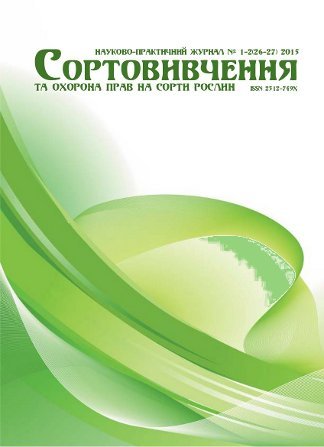Using cluster analysis as a method of classification of the genus Salix L. representatives
DOI:
https://doi.org/10.21498/2518-1017.1-2(26-27).2015.55906Keywords:
cluster analysis, hierarchical method, K-means method, species identification, leaf parametersAbstract
Purpose. To study interactions among the representatives of the genus Salix L. through the cluster analysis, form groups of closely related species and hybrid forms basing on differences of morphological parameters of leaves. Methods. Field, cluster analysis and tree graphics. Results. Willow species were grouped according to absolute parameters of leaf, and three groups of clusters were identified. The degree of affinity between species were assessed using values of an Euclidean distance. Distinctive features of leaf parameters were defined: length of a leaf blade (Ll), distance (cm) between the leaf tip and its maximum width (SDmxT) and the distance between the leaf tip (cm) and the line of its width that corresponds to the length of petiole (SLpT). Conclusions. Using the willow species collection as an example, diagnostically valuable quantitative parameters of leaves were revealed, the use of which allows to identify willow species and hybrid forms through PC applications.
Downloads
References
Tishchenko, V. N., Chekalin, N. M., & Zyukov, M. Ye. (2004). Ispolzovanie klasternogo analiza dlya identifikatsii i otbora vysokoproduktivnykh genotipov ozimoy pshenitsy na rannikh etapakh selektsii [Using cluster analysis for the identification and selection of high-yield genotypes of winter wheat in the early stages of selection]. Faktory eksperimentalnoy evolyutsіi organіzmіv – Factors of experimental evolution of organisms, 2, 270–278 [in Russian].
Gasheva, N. A. (2006). Klassifikatsionno-diagnosticheskaya shkala roda Salix kak vozmozhnost monitoringovykh i taksatsionnykh EVM-testirovaniy [Classification and diagnostic scale of genus Salix as the possibility of monitoring and taxation of computer testing]. Vestnik Orenburgskogo universiteta – Bulletin of the Orenburg University, 4, 23–27 [in Russian].
Chao, N., Gong, G. T., & Liu, J. (1998). On the classification and distribution of the family Salicaceae. Journal of Sichuan Forestry Science and Technology, 19, 9–20.
Gasheva, N. A. (2005). Opyt primeneniya diskriminantnogo analiza dlya razlichiya fenotipicheski skhodnykh vidov iv [Experience of using discriminant analysis to differentiate phenotypically similar species willows]. Vestnik ekologii, lesovedeniya i landshaftovedeniya – Journal of Ecology, Forest and Landscape, 6, 123–130 [in Russian].
Leonchik, Ye. Yu., & Savastru, O. V. (2007). Klasternyy analiz: terminologiya, metody, zadachi: konspekt lektsiy [Cluster analysis: terminology, methods, objectives: lecture notes]. Odessa: Odesskiy nats. un-t im. I.I. Mechnikova [in Russian].
Tsarenko, O. M., Zlobin, Iu. A., Skliar, V. H., & Panchenko, S. M. (2000). Kompiuterni metody v silskomu hospodarstvi ta biolohii [Computer methods in agriculture and biology]. Sumy: Universytetska knyha [in Ukrainian].
Dronov, S. V. (2003). Mnogomerniy statisticheskiy analiz [Multivariate statistical analysis]. Barnaul: Izd-vo Altayskogo gos. un-ta [in Russian].
Bureeva, N. N. (2007). Mnogomernyy statisticheskiy analiz s ispolzovaniem PPP «STATISTICA» [Multivariate statistical analysis using PPP «STATISTICA»]. Nizhniy Novgorod [in Russian].
Downloads
Published
How to Cite
Issue
Section
License
Copyright (c) 2015 Ukrainian Institute for Plant Variety Examination

This work is licensed under a Creative Commons Attribution-ShareAlike 4.0 International License.
Starting in 2022, the copyright to the publication remains with the authors
Our journal abides by the CREATIVE COMMONS copyright rights and permissions for open access journals.
Authors, who are published in this journal, agree to the following conditions:
- The authors reserve the right to authorship of the work and pass the first publication right of this work to the journal under the terms of a Creative Commons Attribution License, which allows others to freely distribute the published research with the obligatory reference to the authors of the original work and the first publication of the work in this journal.
- The authors have the right to conclude separate supplement agreements that relate to non-exclusive work distribution in the form in which it has been published by the journal (for example, to upload the work to the online storage of the journal or publish it as part of a monograph), provided that the reference to the first publication of the work in this journal is included.

























 Ukrainian Institute for Plant Varieties Examination
Ukrainian Institute for Plant Varieties Examination  Селекційно-генетичний інститут
Селекційно-генетичний інститут Institute of Plant Physiology and Genetics of the National Academy of Sciences of Ukraine
Institute of Plant Physiology and Genetics of the National Academy of Sciences of Ukraine
 The National Academy of Agrarian Sciences of Ukraine
The National Academy of Agrarian Sciences of Ukraine